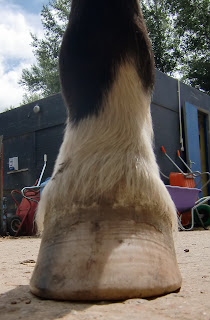Shoes mask weaknesses, barefoot highlights strengths
|
| Solar view - half exfoliated |
 |
Solar view - after |
Tall feet are often seen in shod horses, not so much in the barefoot world.
If you know and use your landmarks it is easy to see just how tall this foot is; and how much it has been shortened, without changing the overall shape much.
The big things to notice are:
- In the before solar view, it is not immediately apparent just how tall the wall has become (in relation to the hard sole plane) - because we can't see anything under the crud. Also can you see the extent of the flare, the stretch in the white line, the thrush and the not 100% healthy frog?
- If you look at the side view before, you can see the foot looks a bit odd. If you follow the healing angle to the ground you can see the toe is scooting out in front. Q. Should we just chop the toe off?
- The front view shows the event lines - these are useful visual markers
- The half exfoliated picture shows where the chalky crud has been flaked off. Note 'flaked', there is no force or cutting involved. One way of doing this, provided the hoof is healthy and sound on stones is to walk the horse on some gravel. Then they self exfoliate. In this case the hoof hasn't had the opportunity - so a gentle flick removes what nature would have.
- A close up view shows you just how far the wall really extends above the hard sole plane.
- In the cleaned up foot; see solar view, the flare and stretched white line have gone. They were products of the overgrowth in this case. You can see traces of the thrush - which can be cleaned out with salt water and cotton buds or a tooth brush. If you look at the toe you can see how you can not bring that back any further without trashing the structure of the foot. This is where some patience is required - we should facilitate correct hoof form, not attempt to force it on the foot.
- In the side view - after you can see how the foot is still flared forward, but I hope you understand that you shouldn't just chop the end off to make it fit a human ideal
- In the front view - after; try comparing the event lines with those from front view - before. Now you can see just how much shorter that toe is.
This is a skilled job and this blog is not a 'how to trim'. The pictures are for learning and discussion purposes only. For interest and context - the foot in question belongs to a robust but not so young native pony. He is out at night and in by day. His carers are devoted to him and take care to feed him a low sugar high fibre diet. His hoof horn quality is excellent, dense but able to flex appropriately when the hoof is loaded. His feet have got so tall because his work load has suddenly decreased because of circumstances not to do with feet. Of course it takes time for the hoof growth to slow down to match the decreased wear, so his feet have 'tin canned'.
















No comments:
Post a Comment